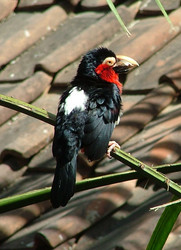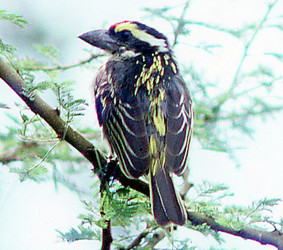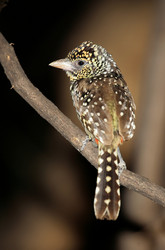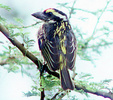African barbets
John Harshman


This tree diagram shows the relationships between several groups of organisms.
The root of the current tree connects the organisms featured in this tree to their containing group and the rest of the Tree of Life. The basal branching point in the tree represents the ancestor of the other groups in the tree. This ancestor diversified over time into several descendent subgroups, which are represented as internal nodes and terminal taxa to the right.

You can click on the root to travel down the Tree of Life all the way to the root of all Life, and you can click on the names of descendent subgroups to travel up the Tree of Life all the way to individual species.
For more information on ToL tree formatting, please see Interpreting the Tree or Classification. To learn more about phylogenetic trees, please visit our Phylogenetic Biology pages.
close boxDiscussion of Phylogenetic Relationships
African barbets probably form a monophyletic group (Moyle 2004). However, several genera are not monophyletic. Stactolaema is not monophyletic, since Gymnobucco, and possibly Buccanodon as well, lies within it. Neither Lybius nor Tricholaema is monophyletic, since T. lachrymosa is apparently within Lybius. It's also unclear whether the remainder of Tricholaema is monophyletic; the genus may be paraphyletic to Lybius.
References
Moyle, R. G. 2004. Phylogenetics of barbets (Aves: Piciformes) based on muclear and mitochondrial DNA sequence data. Mol. Phylogen. Evol. 30:187-200.
Title Illustrations

| Scientific Name | Lybius dubius |
|---|---|
| Location | captive at Niagara Falls Aviary |
| Specimen Condition | Live Specimen |
| Source | bearded barbet |
| Source Collection | Flickr |
| Image Use |
 This media file is licensed under the Creative Commons Attribution-NonCommercial License - Version 2.0. This media file is licensed under the Creative Commons Attribution-NonCommercial License - Version 2.0.
|
| Copyright | © 2006 Ric McArthur |
| Scientific Name | Tricholaema diademata |
|---|---|
| Location | Serengeti NP, Tanzania |
| Specimen Condition | Live Specimen |
| Identified By | self |
| Behavior | perching |
| Life Cycle Stage | adult |
| Body Part | whole |
| View | dorsal |
| Copyright |
© 2006
David Bygott

|
| Scientific Name | Trachyphonus darnaudii |
|---|---|
| Location | Lake Baringo, Kenya |
| Specimen Condition | Live Specimen |
| Source | D'Arnaud's Barbet, Trachyphonus darnaudii, Lake Baringo, Kenya |
| Source Collection | Flickr |
| Image Use |
 This media file is licensed under the Creative Commons Attribution-NonCommercial License - Version 2.0. This media file is licensed under the Creative Commons Attribution-NonCommercial License - Version 2.0.
|
| Copyright | © 2006 Aftab Uzzaman |
About This Page
Correspondence regarding this page should be directed to John Harshman at
jharshman@pacbell.net
Page copyright © 2008 John Harshman
 Page: Tree of Life
African barbets.
Authored by
John Harshman.
The TEXT of this page is licensed under the
Creative Commons Attribution-NonCommercial License - Version 3.0. Note that images and other media
featured on this page are each governed by their own license, and they may or may not be available
for reuse. Click on an image or a media link to access the media data window, which provides the
relevant licensing information. For the general terms and conditions of ToL material reuse and
redistribution, please see the Tree of Life Copyright
Policies.
Page: Tree of Life
African barbets.
Authored by
John Harshman.
The TEXT of this page is licensed under the
Creative Commons Attribution-NonCommercial License - Version 3.0. Note that images and other media
featured on this page are each governed by their own license, and they may or may not be available
for reuse. Click on an image or a media link to access the media data window, which provides the
relevant licensing information. For the general terms and conditions of ToL material reuse and
redistribution, please see the Tree of Life Copyright
Policies.
- First online 27 June 2008
- Content changed 27 June 2008
Citing this page:
Harshman, John. 2008. African barbets. Version 27 June 2008 (under construction). http://tolweb.org/African_barbets/26417/2008.06.27 in The Tree of Life Web Project, http://tolweb.org/











 Go to quick links
Go to quick search
Go to navigation for this section of the ToL site
Go to detailed links for the ToL site
Go to quick links
Go to quick search
Go to navigation for this section of the ToL site
Go to detailed links for the ToL site